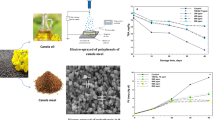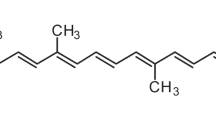Abstract
Microencapsulated quercetin (Q) and epicatechin (E) were prepared by spray-drying using inulin (IN) as encapsulating agent (Q–IN and E–IN) as well as with Capsul (C) as channelizing agent (Q–IN–C and E–IN–C). Microparticles were added to methyl linoleate (ML) and results showed that Q microparticles markedly improved its oxidative stability by increasing the induction period values and delaying the formation of oxidation compounds, as determined by high-performance size-exclusion chromatography, with respect to E microparticles, thus suggesting the importance of flavonoid C-ring substitution. Remaining levels of Q in the lipid system throughout oxidation of ML added with Q microparticles seemed to show two releasing zones: the first one corresponds to the equilibrium zone, when Q released from microparticles replaces Q that is being degraded; the second zone corresponds to the degradation of Q, when the release rate of the encapsulated Q is slower than its degradation rate. In contrast, E microparticles showed only one zone corresponding to the release of surface E. The end of the induction period was in line with the exhaustion of Q and E and the initiation of formation of advanced oxidation products (polymers). In conclusion, Q microparticles have a potential application to extend the shelf-life of lipid matrixes.



Similar content being viewed by others
Abbreviations
- C:
-
Capsul
- E:
-
Epicatechin
- IN:
-
Inulin
- ML:
-
Methyl linoleate
- Q:
-
Quercetin
References
Márquez-Ruiz G, Ruiz M, Velasco J, Dobarganes M (2010) Preventing oxidation during frying of foods. In: Decker E, Elías R, Mc Clements D (eds) Oxidation in foods and beverages and antioxidant applications. Woodhead, Copenhagen, pp 239–273
Ito N, Hiroze M, Fukushima G, Tauda H, Shira T, Tatematsu M (1986) Studies on antioxidants: their carcinogenic and modifying effects on chemical carcinogenesis. Food Chem Toxicol 24:1071–1082
Huber G, Rupasinghe H, Shahidi F (2009) Inhibition of oxidation of omega-3 polyunsaturated fatty acid and fish oil by quercetin glycosides. Food Chem 117:290–295
Naz S, Siddiqi R, Sayeed S (2008) Effect of flavonoids on the oxidative stability of corn oil during deep frying. Int J Food Sci Technol 43:1850–1854
Tsimogiannis D, Oreopoulou V (2007) Defining the role of flavonoid structure on cottonseed oil stabilization: study of A- and C-ring substitution. J Am Oil Chem Soc 84:129–136
Leopoldini M, Russo N, Toscano M (2011) The molecular basis of working mechanism of natural polyphenolic antioxidants. Food Chem 125:288–306
Pedrielli P, Skibstead L (2002) Antioxidant synergy and regeneration effect quercetin, (−)-epichatequin, and (+)-catechin on α-tocopherol in homogeneous solutions of peroxidating methyl linoleate. J Agric Food Chem 50:7138–7144
Pekkarinen S, Heinonen M, Hopia A (1999) Flavonoids quercetin, myricetin, kaemferol and (+)-catechin as antioxidant in methyl linoleate. J Sci Food Agric 79:499–506
Wanasundara U, Shahidi F (1994) Stabilization of canola oil with flavonoids. Food Chem 50:393–396
Wanasundara U, Shahidi F (1996) Stabilization of seal blubber and menhaden oils with green tea catechins. J Am Oil Chem Soc 73:1183–1190
Wanasundara U, Shahidi F (1998) Stabilization of marine oils with flavonoids. J Food Lipids 5:183–186
Sun-Waterhouse D, Wadhwa S, Waterhouse G (2013) Spray-drying microencapsulation of polyphenol bioactives: a comparative study using different natural fibre polymers as encapsulant. Food Bioprocess Technol 6:2376–2388
Waterhouse GIN, Wang W, Sun-Waterhouse D (2014) Stability of canola oil encapsulated by co-extrusion technology: effect of quercetin addition to alginate shell or oil core. Food Chem 142:27–38
Wang W, Waterhouse GIN, Sun-Waterhouse D (2013) Co-extrusion encapsulation of canola oil with alginate: effect of quercetin addition to oil core and pectin addition to alginate shell on oil stability. Food Res Int 54:837–851
Palma A, García P, Márquez-Ruiz G, Vergara C, Robert P (2014) Release kinetic of flavonoids in methyl linoleate from microparticles designed with inulin and channelizing agent. Food Res Int 64:99–105
Márquez-Ruiz G, Holgado F, García-Martínez M, Dobarganes M (2007) A direct and fast method to monitor lipid oxidation progress in model fatty acid methyl esters by high-performance size-exclusion chromatography. J Chromatogr A 1165:122–127
Rice-Evans C, Miller J, Paganga G (1996) Structure-antioxidant activity relationship of flavonoids and phenolic acids. Free Radic Biol Med 20:933–956
Sansone F, Picerno P, Mencherini T, Villeco F, D’Ursi AM, Aquino RP, Lauro MR (2011) Flavonoid microparticles by spray-drying: influence of enhancers of the dissolution rate on properties and stability. J Food Eng 103:188–196
Sun-Waterhouse D, Wang W, Waterhouse GIN (2014) Canola oil encapsulated by alginate and its combinations with starches of low and high amylose content: effect of quercetin on oil stability. Food Bioprocess Tech 7:2159–2177
Gharsallaoui A, Roudaut G, Chambin O, Voilley A, Saurel R (2007) Applications of spray-drying in microencapsulation of food ingredients: an overview. Food Res Int 40:1107–1121
Moreira E, Barbosa J, Gomes T, Oliveira R (2002) Thermal characterization of the quercetin and rutin flavonoids. Thermochim Acta 392–393:79–84
Acknowledgements
This work was part of Fondecyt project Grant No. 1120308 (Conicyt-Chile) and ACT project Grant No. 1105/2012 (Conicyt-Chile).
Author information
Authors and Affiliations
Corresponding author
About this article
Cite this article
Palma, M., Márquez-Ruiz, G., García, P. et al. Effect of Spray-Dried Flavonoid Microparticles on Oxidative Stability of Methyl Linoleate as Lipid Model System. J Am Oil Chem Soc 94, 99–105 (2017). https://doi.org/10.1007/s11746-016-2920-8
Received:
Revised:
Accepted:
Published:
Issue Date:
DOI: https://doi.org/10.1007/s11746-016-2920-8




